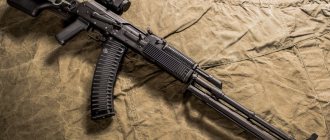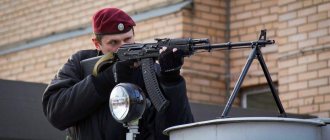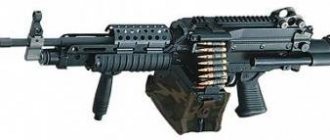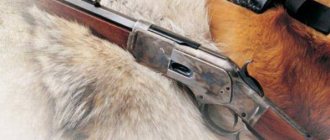At the beginning of the twentieth century, a triumphal march of automatic weapons began across the battlefields, one of the most successful examples of which is the Lewis light machine gun.
The fusion of revolutionary solutions and dead-end moves took its place on the pedestal of the most long-lived weapons, along with the masterpiece of Hiram Maxim. Few people know that the modern Pecheneg machine gun, for the first time in a hundred years, repeated the basic design of the barrel cooling tested on Lewis mod. 1913.
But there were also plenty of dead-end solutions - the use of a springless magazine, leaf spiral springs in the mechanism and an overcomplicated bolt. But first things first.
History of the development of the Lewis light machine gun
The first developments in this area belonged to the American Samuel McLean, but further development and “bringing to mind” was undertaken by Colonel of the American Army Isaac Lewis. It is curious that the colonel initially planned to create a water-cooled heavy machine gun, but abandoned this idea due to the niche being occupied by the already proven developments of Maxim and Browning.
A forced air-cooled light machine gun is introduced in 1913, but does not attract the attention of the US War Department, after which Lewis begins production in Europe. Thus, the company Armes Automatique Lewis is founded in Liege, Belgium, and production in the UK is carried out under the auspices of Birmingham Small Arms (later American industry gets involved in the business). In the same year, the Belgian army adopted the Lewis guns, and already in 1914 they successfully used them with the outbreak of the First World War.
The first batch of ten samples arrived in Russia in July 1913 for testing at the Officer Rifle School. Having appreciated the new model in comparison with the existing bulky analogues, two years later a decree was issued on the mass acquisition of the Lewis system for installation on light airplanes. Before the start of the revolutionary events, approximately 9,500 Lewis guns of American origin were purchased (for Mosin rifle ammunition) and about 1,900 British models (caliber .303 British).
One of the first models - this can be determined by the shape of the bipod
Recommendations
- Bullock, Arthur (2009). Gloucestershire Between the Wars: A Memoir
. History Press. ISBN 978-0-7524-4793-3. Pages 62-64, 66, 69-70, 85-86. - Chant, Christopher (2001). Small arms of World War II
. London (UK): Brown Collectibles Co. ISBN 978-1-84044-089-8. - Ford, Roger (2005). The World's Great Machine Guns from 1860 to the Present Day
. London: Amber Books. ISBN 978-1-84509-161-3. - Glanfield, John (2001). Chariots of the Devil - The Birth and Secret Battles of the First Tanks
. Stroud: Sutton. ISBN 978-0-7509-4152-5. - Grant, Neil (2014). Lewis pistol
. Oxford (UK): Osprey. ISBN 978-1-78200-791-3. - Hogg, Ian W. (1978). The Complete Illustrated Encyclopedia of Firearms Around the World
. & W. ISBN 978-0-89479-031-7. - Hogg, Ian W.; Batchelor, John (1976). Machine Gun (Purnell's History of the World Wars Special)
. London: Feb. - Skennerton, Ian (1988). British Small Arms of the First World War 2
. Margate Q (Australia): Ian Skennerton. ISBN 978-0-949749-09-3. - Skennerton, Ian (2001). .303 Lewis Machine Gun
. Small arms identification series. Gold Coast QLD (Australia): Arms and Militaria Press. ISBN 978-0-949749-42-0. - Smith, Joseph E. (1973). Small Arms World
(10 Rev. ed.). Harrisburg PA (USA): Stackpole Book. ISBN 978-0-88365-155-1. - Smith, W. H. B. (1979). 1943 A Concise Guide to Military Small Arms
(FACS. Ed.). Harrisburg PA (USA): Stackpole Book. ISBN 978-0-8117-1699-4. - Textbook of Small Arms 1929
(Magnesia. Ed.). London (UK), Dural (NSW): Rick Landers: HMSO for the War Office. 1999. OCLC.
Description of design and principle of operation
The already generally accepted principle of removing powder gases did not bypass this machine gun. Of the technical solutions that distinguish Lewis from its analogues, it is especially worth noting a special valve on the gas chamber to regulate the rate of fire, the extraordinary structure of the disk magazine along with the feeding mechanism. The magazine did not have a feed spring, so it rotated with a protruding tail on a spring. The purpose of the unusual-looking casing was forced air cooling: at the moment of firing, the powder gases, “stuck” in the casing, forced cold air to circulate along the barrel due to its rarefaction in the rear part and the temperature difference.
However, it is worth noting that although the aircraft version of the machine gun was produced without such a device, this did not create difficulties when using it by units of the British army, so the casing can be considered a design excess. It also looks unusual to abandon a cylindrical return spring in favor of a leaf spring. Due to its wear and shrinkage after long-term shooting, a special key was added to the set of accessories for the machine gun to tighten the spring.
Main design elements:
- Barrel (with casing and radiator);
- Receiver;
- Gate;
- Bolt carrier;
- Box with return spring;
- Shop;
- Bipod (later one telescopic).
American training poster, caliber used - .30-06
The firing mechanism is of the striker type, mounted on the bolt carrier post. The barrel bore was locked by turning the curvilinear groove of the bolt. The fuse was located on the receiver, and the design of the trigger mechanism excluded the possibility of firing single shots, which often led to excessive consumption of cartridges, taking into account the small capacity of the disk magazine.
The history of the appearance of the machine gun and a little from the life of its designer
The creator of this weapon is considered to be American Army Colonel Isaac Lewis. He was a talented and educated officer. He studied at West Point Academy, and after that, in 1911, he became head of the artillery school located at Fort Monroe. He remained in this post almost until the end of his service and retirement. During this time, Colonel Lewis's activities included scientific work and weapons development, and he also became famous as a first-class electrical engineer and mechanic. Before retiring, Lewis chose a calling for himself - he became a consultant at the Automatic Arms Company. While working there, he became interested in one of the prototypes of an infantry machine gun, the designer of which was a certain Samuel McLean. Lewis then used many of the solutions and design features of these weapons when developing his own weapons.
Lewis applied for his inventions many times, but never received a response. Since the command of the US Army was not then interested in the developments of their country's designers, he took a slightly different path. In 1912, a friend of Lewis, an officer at that time in such a young branch of the military as aviation, Captain Chandler, agreed to test a model of a machine gun on a Wright biplane. One of the pilots, Lieutenant Milling, was also involved in this.
Despite the fact that the machine gun proved itself quite well, the army command still did not pay due attention to it. Yes, official tests were carried out, but preference was given to a foreign-made machine gun, the Bene-Mercy. This French weapon was in many ways inferior to the Lewis machine gun. In addition, it had a specific power supply from special rigid tapes, which made working with it more difficult. This government position forced Lewis to move to Europe, resigning from the US Army.
Lewis machine gun cartridges
The “British of American origin” had practically no worthy opponents in his niche. For example, the German MG 08/15 was essentially a Maxim, having lost weight compared to the original, but was still too bulky. The French Shosha model was too unreliable and vulnerable to contamination, and its closest opponent, the Danish Madsen, despite its relative success, had absolutely no development potential due to a number of initial shortcomings. This situation allowed the designer to extract maximum benefit from his invention, and the machine gun was mass-produced for the following ammunition:
- .303 British (7.69*57 mm);
- Mosin rifle cartridge (7.62*54 mm);
- .30-06 Springfield (7.62*53 mm);
- .256 Mannlicher (6.5*53 mm);
- Less known options, in particular, chambered for the German 8 mm cartridge.
The first two options from this list are the most widespread.
The original magazine is easily recognized by the absence of a spring
Operating countries
- Russia - deliveries of machine guns (chambered .303 British) began in 1916. In total, before June 1, 1917, 9,600 American-made Lewis machine guns and 1,860 English-made machine guns were delivered to Russia. The machine guns of American origin were chambered for the 7.62 mm Mosin cartridge (stamp on the butt plate - 0.3). The British fired the .303 British cartridge.
- White movement - used by white units during the Civil War.
- RSFSR: Lewis light and heavy machine guns were used by the Red Guard during the revolution and the establishment of Soviet power and the Red Army during the civil war and the fight against the Basmachi in Central Asia.
- RSFSR USSR: were in service with the Red Army until 1926, after which they were transferred to storage warehouses, and the Dp-27 became the main light machine gun. Later, machine guns from tsarist warehouse stocks were in service with militia divisions and were used during the Battle of Moscow.
- Republic of Spain - 7.7 mm machine guns, .303 British cartridge. The Republicans were supplied with 800 machine guns.
- German Empire - captured examples, which were much lighter than the MG08/15 used in the First World War.
- Germany used captured machine guns from the First World War. Along with other trophies from both world wars, the Lewis entered service with the Volkssturm.
Performance characteristics
For a general understanding, the following table shows the parameters of the first British production model. The differences with analogues adapted for other calibers are minimal.
| Length | 1280 mm |
| Barrel length | 665 mm |
| Weight without cartridges | 11.8 kg |
| Rate of fire | 500-600 rounds per minute |
| Maximum firing range | 1850 m |
| Magazine capacity | 47 or 97 rounds |
| Initial bullet speed | 750 meters per second |
Despite the fact that the Lewis gun (this is how it is written in English, this is the official name in the ranks of the British armed forces) successfully coped with its main task - supporting infantry in the offensive and even earned the nickname “a machine gun you can run with” in history Various designs of machines and tripods for it have been preserved.
Firing range
The machine gun played an important role in this war. Wartime practice showed that the victory was always won by the side that was armed with machine guns. At the same time, planes and tanks began to join the machine guns. The firing range and ballistics of the rifle cartridges made it possible to keep the enemy at a great distance, preventing him from going on the offensive.
Machine gunners could also be united into a squad, where they, mutually covering each other, would ensure complete control over enemy positions and shelters. Along with artillery fire, these weapons caused enormous loss of life. Essentially, the Lewis rifle was an automatic firing system equipped with a gas chamber and air cooling. She weighed about 13 kilograms. The machine gun was loaded with a 30-06 Springfield round drum, and its rate of fire was from 500 to 600 rounds per minute. The firing range varied from 800 to 3000 meters.
A distinctive feature of the Lewis machine gun was its casing. It was intended to protect the shooter from contact with a hot barrel and to better blow it through the forced cooling system. This system operated using waste powder gases and was innovative and very effective for its time. The machine gun, which had forced air cooling, stood out favorably from its competitors, which were cooled by water. It did not require additional refilling with water and could easily be handled by one person (unlike Vickers).
By the time America adopted the Lewis machine gun, this weapon had already proven itself in battles around the world. America did not enter World War I until 1917. By this time, Lewis already had wide popularity and was used almost everywhere. Especially often, aircraft and biplanes of the Allied forces were equipped with this machine gun. There was a serious shortage of firearms in the US Army. This forced America to purchase Lewis machine guns from Britain, and they remained in American service until the end of World War II, despite the fact that in parallel the Americans also purchased the Czech Bren Light Machine machine gun.
Pros and cons of weapons
Repeating what was mentioned above, the Lewis was the absolute leader among infantry weapons. Primarily due to the fact that now a two-man machine gun crew (the first number carries the weapon itself and two disc magazines, the second carries additional ammunition) became as mobile as most of the infantry armed with rifles (later - PP). There are also successful examples of use both in aviation on aircraft that are unable to carry heavier weapons, and as an air defense weapon. Until the 1940s, a number of machine guns were equipped with special wire sights.
The main disadvantage was the low density of fire - a standard magazine of 47 rounds with a mass of almost two kilograms was discharged in three seconds. The disk magazine was often criticized due to its constant rotation, which, if handled carelessly, often injured the shooters' fingers and led to misfires.
Notes
- Semyon Fedoseev. Russian career of the Madsen submachine gun (part II) // Master Gun magazine, No. 3 (156), March 2010. pp. 58-63
- Semyon Fedoseev. Russian career of the Madsen submachine gun (part III) // Master Gun magazine, No. 6 (159), June 2010. pp. 42 - 51
- S. L. Fedoseev. Russian machine guns. Heavy fire. M., Yauza - EKSMO, 2009. pp.81-82
- S. L. Fedoseev. Russian machine guns. Heavy fire. M., Yauza - EKSMO, 2009. p.86
- Skennerton (2001), p.46–47
- Sergey Monetchikov. Submachine guns for the Volkssturm // “Weapons” magazine, No. 2, 2002 (special issue “Infantry weapons of the Third Reich. Part IV. Submachine guns”)
- Ford, Roger. The greatest machine guns from 1860 to the present day. London, 2005 – p.70 ISBN 1-84509-161-2.
- S. L. Fedoseev. Russian machine guns. Heavy fire. M., Yauza - EKSMO, 2009. pp.81-82
- S. L. Fedoseev. Russian machine guns. Heavy fire. M., Yauza - EKSMO, 2009. p.86
- Venkov A.V.
Ataman Krasnov and the Don Army, 1918. - M.: Veche, 2008. - P. 313 - 480 p. — ISBN 978-5-9533-2098-6. - Konev A. M.
Red Guard in defense of October. — 2nd ed. - M.: Nauka, 1989. - P. 29-30 - 336 p. - Zhuk Yu. A.
Unknown pages of the battle for Moscow. - M.: AST, 2008. - P. 65 - 731 p. — ISBN 978-5-17-039641-2.
Lewis gun modifications
In addition to adaptations for various calibers, the British continued to develop the idea of the designer.
Version chronology:
- Infantry modification Mk1 - a slightly modified model;
- Mk2 - specifically for air combat. Added a second handle for control, instead of the butt. For the first time, 97-round magazines are used, a bag for cartridges appears, the casing and radiator are shortened, and a flash suppressor is added;
- The Mk3 was redesigned from those already in service: the automation was improved and the gas outlet was enlarged.
Also widely used in Japanese aviation is a licensed copy - Type 92.
This particular sample was found among the props of a domestic film studio.
Application in history
Soon after being adopted, the first shots from the Lewis were fired in combat conditions. In the European theater of operations, it was valued by all warring parties for its multitasking and mobility. Soldiers from countries where it was not adopted sought to obtain it as a trophy.
But this model earned its greatest fame a little later, becoming the most recognizable of the machine guns of the Civil War. Now the Lewis MMG is almost a mandatory prop in any film about the confrontation between the “reds” and the “whites”. He earned special love among the Makhnovists - Makhno’s personal guards were entirely armed with them.
After the revolution, Lewis system machine guns lay in huge quantities in the warehouses of the Red Army until the beginning of World War II. The first of the formed divisions went to the front with them straight from the 1941 parade, and they were also massively equipped with militia units like the Tula Workers' Regiment.
The last conflict where the massive use of the American designer’s system was noticed was the Korean War.
I invite readers to discuss - was this system ahead of its time or turned out to be an unnecessary quirk of the designer?
We are waiting for your comments.
users
- Armée de Liberation Nationale Guerrillas
- Australia
- Barbados
- Belgium
- Bermuda: Bermuda Volunteer Rifle Corps
- Biafra
- North Borneo
- Bolivia
- Canada
- Ceylon
- Republic of China: used by military commander of the army
- Czechoslovakia
- Estonia in reserve in 1940.
- Fiji
- Finland: used as 7.62 pk/Lewis
and
7.70 PK/Lewis - France
- Democratic Republic of Georgia (Mostly People's Guard and some army units in 1918-1921)
- German Empire (which found it much easier than the MG08/15)
- Nazi Germany
- Guiana
- British Hong Kong
- British India
- Ireland
- Israel
- Italy: infantry variant modified for aircraft use
- Empire of Japan
- Latvia: LMG standard in the Latvian War of Independence and interwar period. Used by Latvian police battalions 2.
- British Malaya
- Mauritius
- Mexico
- Netherlands
- Nicaragua
- Norway: manufactured before World War I
- Northern Rhodesia
- Southern Rhodesia
- Philippines
- Poland
- Portugal
- Romania
- Russian empire
- Somaliland: Somaliland Camel Corps
- Soviet Union
- Spanish Republic
- Tibet
- Transjordan
- United Kingdom and British Empire
- United States
- Vietnam
- Kingdom of Yugoslavia
- New Zealand









